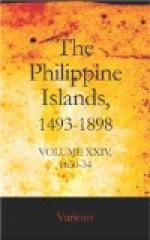Perhaps the reason is that in collecting them no attention
is paid to what is produced. Besides that, the
governor knew that the Dutch were settled in Hermosa
Island, a very large island, which lies more than
two hundred leguas north of Manila. It is called
Hermosa [i.e., “Beautiful”] Island
because of its fertility. It is quite near China,
although it is inhabited by Indians, like the rest
of the islands. The governor thought that, from
that place, the Dutch were depriving us of the trade;
this would mean the destruction of Manila, which only
a lucrative trade could sustain. To remedy all
this, he thought to capture Hermosa Island, and he
discussed and conferred about this plan. The
Dominican fathers, influenced by the gain of souls,
encouraged this affair, because of the nearness of
the island to China. As all are dependent on
the governor in these regions, no one dares to contradict
him in whatever pleases him; for they fear his anger
upon them, which often deprives them of sustenance.
But, I think time has proved what an unwise thing
was done; for none of those injuries have been remedied,
but have remained. The forces, which are daily
becoming fewer in the islands, were divided, and there
were innumerable other inconveniences. Finally,
the governor sent troops to the island, and possession
of it was taken, more than forty or sixty leguas from
the Dutch fort. Only Dominican religious went
on this occasion. Then it befell that many of
the troops died, for the island is very cold.
Most of the fruits of Castilla are raised there.
Its inhabitants are fierce, and live without law or
reason, but more as their chiefs dictate. Ours
have suffered signal hardships there. Sargento-mayor
N. Careno was governor of that fort and the troops;
and he did his utmost. The Chinese came and offered
many things when the soldiers had money; but, when
money failed, all was about to perish. That year,
1626, Don Juan Nino de Tabora came as governor.
He was told of Hermosa Island and its great importance.
Accordingly, he resolved to make an expedition thither,
with as many of the remaining soldiers as possible.
They filled three large galleons and other smaller
ones. Captain Lazaro de Torres, of whom we have
made so much mention, sailed in the “Trinidad,”
the smallest of all the ships. They left in August,
after the despatch [for New Spain] of the vessels
of 1627. The weather was rough, so that the governor
grew afraid. After incurring so great expenses
for his Majesty, and sailing in galleons which carried
fifty or sixty pieces of artillery, a return was made
to Cavite. Only Lazaro de Torres went ahead, with
whom sailed father Fray Lucas de Atienza, of our order,
as prior and vicar-provincial. They suffered
terrible storms, and ran manifest dangers; especially
when, running with the lower sail on the foremast,
they ran aground on an island, which they had not seen
because of a dense fog. At last they all got
away. They flung out, or rather raised, the greater




